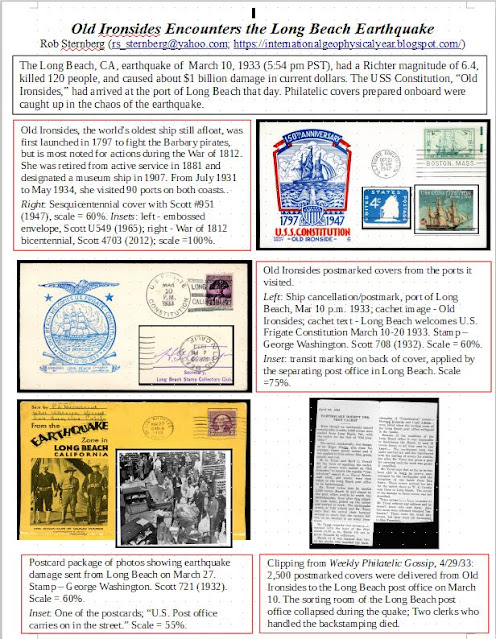The American Topical Association has now posted its 3rd annual round of 1-page exhibits on philatelic topics.
In 2021, I contributed a 1-page exhibit derived from my IGY collection, showing one IGY stamp from each of the 19 countries that issued IGY stamps between 1957 and 1959.You can find a copy of my exhibit here.
Last year, using my other philatelic collection on North American earthquakes, my 1-pager was about the encounter of the USS Constitution, aka Old Ironsides, with the Long Beach earthquake of March 10, 1933. You can see that poster here.
This year I have returned to the IGY for my ATA 1-page exhibit. After I bought the IGY cover signed by Lloyd Berkner that I shared in my last post, I decided to do my exhibit featuring covers signed by significant figures in the IGY. That exhibit is posted here, or you can see it below. It shows 5 first day covers bearing the U.S. IGY stamp (Scott 1107) and involving arguably the top 5 (or at least 5 of the) most influential CSAGI (Chapman and Bartels) and U.S. (Kaplan, Shapley, and Odishaw) officers of the IGY. Four of the covers are signed. The Kaplan cover has no signature, but it does include a cachet with his picture.
 |
| My ATA 1-page exhibit for 2023 |
In an earlier post, I mentioned that CSAGI's (Comité Spécial de l'Anée Géophysique Internationale) five officers (see photo below) included Sydney Chapman (president) and Lloyd Berkner (Vice President). That post included the cover with Chapman's signature.
 |
| A meeting of the Special Committee for the International Geophysical Year, known by its French acronym CSAGI, in Brussels in June 1957, included Vladimir V. Beloussov of the Soviet Union, left, Lloyd V. Berkner of the United States, [Marcel] Nicolet [of Belgium], Jean Coulomb of France, and Sydney Chapman of the United Kingdom (NASA) |
The U.S. National Committee for the IGY included Hugh Odishaw as its executive director. I also previously showed my cover signed by Odishaw.
I couldn't really find any online sites that describes the U.S. IGY Committee. In another earlier post, I mentioned that I own a copy of the Proposed United States Program for the International Geophysical Year, 1957-58, a 105-page document published in 1955 by the United States National Committee for the International Geophysical Year. It states in the introduction (p. ix) that organizations critical for each nation that developed its own IGY program would be the "adhering bodies" which would provide the focuses (foci) for those national committees and their programs. In the U.S., this body was the National Academy of Sciences-National Research Council. In turn, the Academy organized the U.S. National Committee for the IGY to "plan, direct, and execute the IGY program." The Committee members were listed inside the front cover shown, where you will see the names of Kaplan, Shapley, and Odishaw.
 |
| People on the U.S. National Committee for the IGY |
I found a rather informative, chatty and interesting transcription of an oral interview with Alan Shapley by historians of science Ron Doell and Fae Korsmo, much of it about the IGY and its organization. Lots of interesting history and anecdotes, including about Chapman, Bartels, Kaplan and Odishaw, told with humor and some colorful observations of various participants. The interview was done in 2003, by which time Shapley had long survived these other luminaries (Chapman, 1888-1970; Berkner,1905-1967; Kaplan,1902-1991; Shapley, 1919-2006; Odishaw, 1916-1984), so that allowed him to be quite candid about the IGY program and its personnel:
"Berkner was the wheeler-dealer" in the formulation of the IGY.
He "didn’t want to be involved nationally in the US program ... So they hit upon Joe Kaplan, of UCLA, whose claim to fame was not really in geophysics. But he identified what are now known as the Vegard-Kaplan bands in the spectrum of the aurora. That’s almost the only thing he did except defend their football team."
"How they hit upon me [Shapley himself], I don’t know."
"Chapman that said he had to solve or take the problems globally instead of as polar-wise [like the First and Second International Polar Years]. So I don’t think Berkner should get any credit for broadening things."
"Merle Tuve ... was a member of the US National Committee, and he was a very feisty person. A wonderful person, in contrast to some of the other people."
"Odishaw’s first reaction on the International Geophysical Year was 'What the hell is that?' "
"Hugh and I were buddies. Joe Kaplan was a mouthpiece. Not to denigrate him, but Hugh and I did all the tactics and strategy."
"I was Staff Sergeant for the whole US program. Hugh and I were running the U.S. program. We manipulated Joe Kaplan as necessary."
Next year I may do a similar 1-page exhibit with signatures of 5 other prominent IGY scientists. Stay tuned.







































